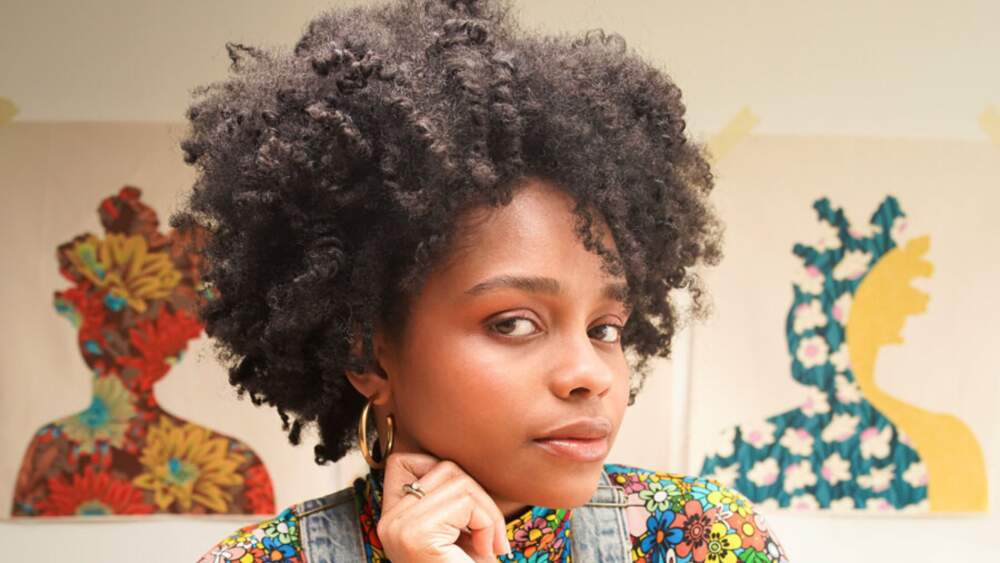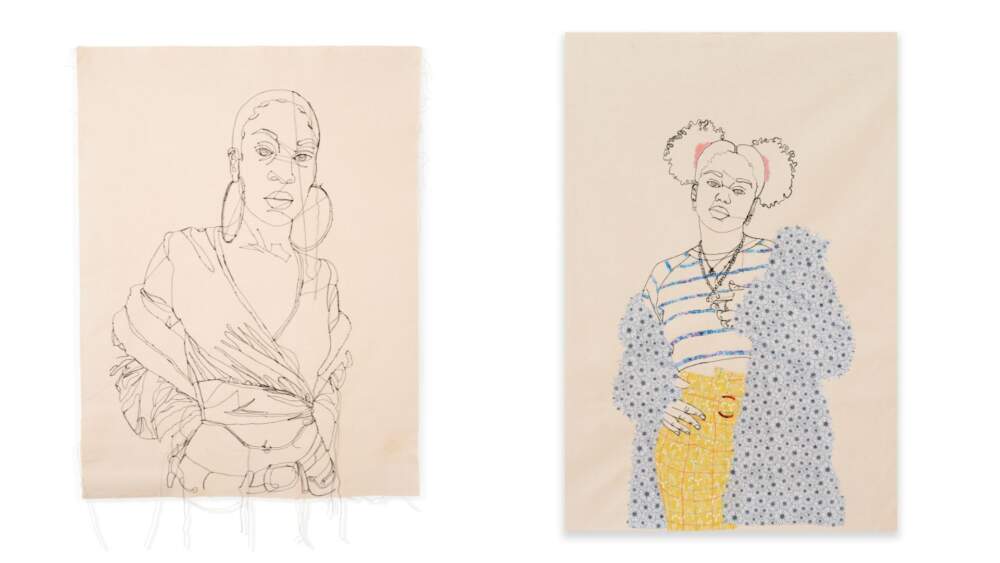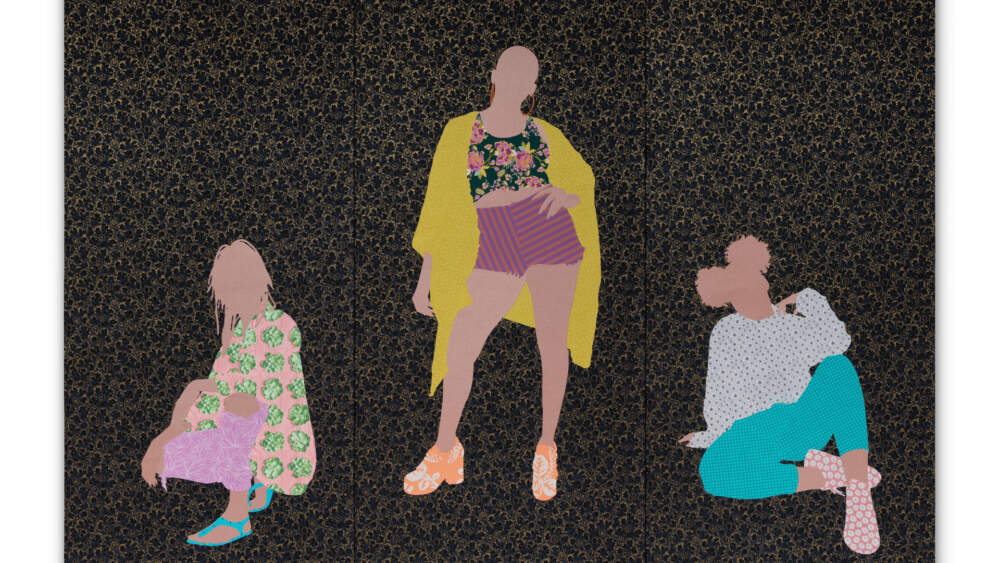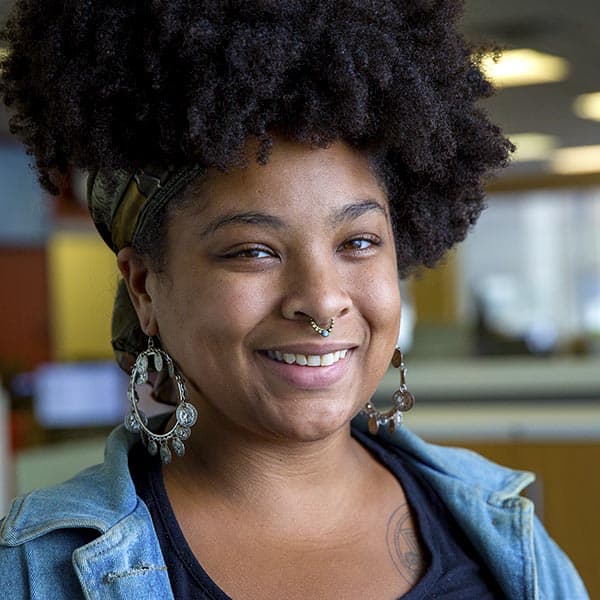Advertisement
Commentary
At the Peabody Essex Museum, artist Gio Swaby explores Black womanhood through fabric

Growing up, I used to watch my mother get ready to go out. It was one of my favorite things to do. She worked long hours during the week and would indulge in a night out every once in a while to unwind. I'd sit on her bed and watch her line her lips with brown pencil and pack neutral-toned eyeshadows on her eyelids. She'd drape herself in jewelry and then slip on her outfit. With the transformation complete, she left our apartment, confident and ready to take on the world.
This scene — of a child watching their mother get ready to go out — may seem mundane. But for Black women, aesthetics and embellishment choices are a reclamation of an autonomy we are often robbed of in the real world. My mother's ability to decide how she looked was a direct subversion of the standards she was expected to uphold in her everyday life — at her job, in predominantly white "professional" spaces, and in public. Her purposeful and deliberate adornment was an act of rebellion.
As I ventured through "Gio Swaby: Fresh Up" at the Peabody Essex Museum, I thought of those nights watching my mother. The exhibit is awash in color, with walls wrapped in bright, patterned wallpaper inspired by Swaby's work. Swaby, who is Bahamian, utilizes thread and fabric to create portraits of women and girls from the Bahamas. The daughter of a seamstress who introduced her to the world of textiles, Swaby explores the tender connections between Black womanhood, personal style and liberation. It's part of the reason why she chose to call the exhibit "fresh up." The Bahamian phrase means one exudes a sense of individuality and confidence through clothing and fashion.

Some of her portraits are figurative, accurately replicating the anatomy of a subject's face and outfit with thread, like her "Another Side to Me" series. Others are more abstract, with colorful shapes and limbs coalescing to form striking silhouettes. "These pieces are a dedication to the individual people represented in them," Swaby says. "But to me, it shows gratitude to that larger network of knowledge that I've pulled from to develop this practice, to develop my visual language and my conceptual underpinnings for this work."
That network of knowledge Swaby is referencing is Black feminist thought. Swaby began to think deeply about it after reading passages from bell hooks' "Talking Back: Thinking Feminist, Thinking Black." "It was like unlocking a whole new world for me of understanding. It doesn't have to be complicated to be complex. It can be extremely expansive ... without having to have all of the additional complications."
For Swaby, the question of who her work is for is very simple. She creates for girls and women like her — Black and living in a world that has prescribed notions of what Black womanhood should look like. Because of that, autonomy is central to how Swaby generates her work. Subjects, who she photographs and uses as references for her portraits, have a choice in how they're portrayed. "I want them to choose their own outfits," Swaby notes. "Choose your own poses. The process is very intimate."

That choice in how they are represented to the world is extremely important. This is especially apparent in Swaby's depictions of her three older sisters — Melissa, Juranda and Natasha — in her series "Love Letter" and "Pretty Pretty." Small details, like their choice in footwear, their hairstyles and acrylic nails, are highlighted. This reclamation of clothing, accessories and hair as expressions of agency underscores the fact that aesthetic choices are about much more than how we appear to the world — our aesthetic choices can help liberate us. "To say 'I'm gonna dress how I want and represent myself in a way that feels authentic and real' is a journey," Swaby points out. "It's a kind of resistance."
Through her portraits, Swaby also resists and strains against flattened caricatures of the Bahamas and its inhabitants that are often perpetuated by the tourism industry. Documenting personal style creates a "lexicon of Black Caribbean style and what that looks like in the contemporary," she says. "A lot of how we understand the Caribbean and Bahamian people is thought about in past tense." Swaby reminds viewers that the people of the Bahamas are living, breathing beings who exist in the present.
Advertisement
Her use of Androsia Batik fabric in "Love Letter 4" and "Gyalavantin’" is a commentary on the tension between Bahamian culture and the region's history as a tourist destination. "It was developed on the island of Andros and is made by Bahamians," Swaby says. Sponges are used to create patterns of organic shapes and materials, like flowers and coral, on brightly colored fabrics. Though it's been appropriated to create products geared toward tourists, the fabric is deeply connected to Bahamian identity and history. "We've all worn it for different special occasions. My mom wore it when she was a dancer in the first independence ceremony in 1973. Using it is about celebrating my culture and where I'm from."

Ultimately, that is what "Fresh Up" is all about — a celebration of the threads that bind us to each other. For me, there is an intimacy and sentimentality ingrained in Swaby's work because we can see ourselves in her portraits and in her story. Swaby is keenly aware of the silos that exist in the art world that have kept people who look like her from patronizing museums and other art spaces. It's why accessibility is central to her artistic practice. Textiles, particularly textile traditions rooted in Afro Diasporic cultures, haven't been treated with the same levity other art forms have. This is particularly true because of textiles' ties to domestic forms of making like sewing and quilting.
Yet textiles and other modes of craft art are often what is readily and widely available, with techniques passed down from generation to generation, as Swaby's mother did with her. "I feel like people could look at this and understand, like, it doesn't need to be oil paint, it doesn't need to be charcoal," says Swaby. "There are other forms of making, and for me, it's an anti-colonial approach to making this work, to prioritizing other forms of knowledge, to prioritizing other kinds of experiences."
"Fresh Up" is a colorful reminder that we, Black women and girls in particular, can fashion the fabric of our autonomy. That liberation is not some complex, distant concept. It can be as simple as putting on an outfit, looking in the mirror and declaring yourself free.
"Gio Swaby: Fresh Up" is on view at the Peabody Essex Museum through Nov. 26.
